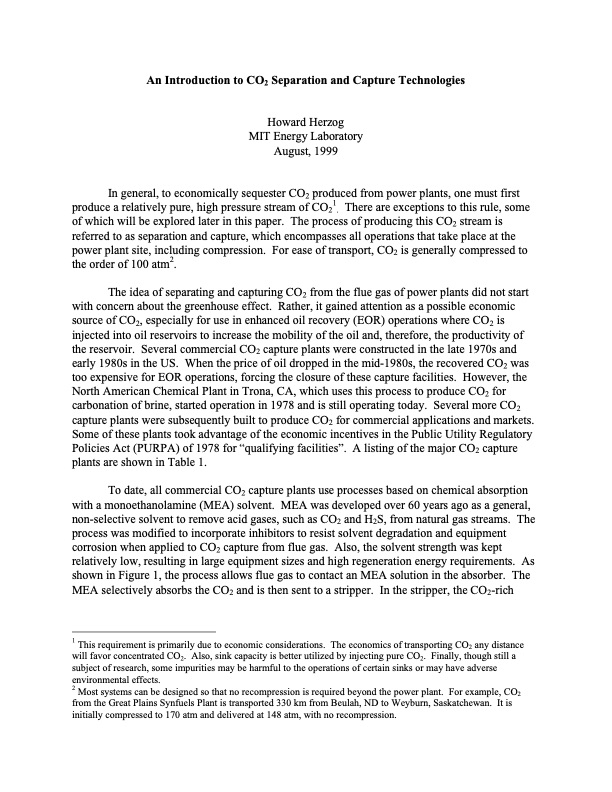
PDF Publication Title:
Text from PDF Page: 001
An Introduction to CO2 Separation and Capture Technologies Howard Herzog MIT Energy Laboratory August, 1999 In general, to economically sequester CO2 produced from power plants, one must first produce a relatively pure, high pressure stream of CO21. There are exceptions to this rule, some of which will be explored later in this paper. The process of producing this CO2 stream is referred to as separation and capture, which encompasses all operations that take place at the power plant site, including compression. For ease of transport, CO2 is generally compressed to the order of 100 atm2. The idea of separating and capturing CO2 from the flue gas of power plants did not start with concern about the greenhouse effect. Rather, it gained attention as a possible economic source of CO2, especially for use in enhanced oil recovery (EOR) operations where CO2 is injected into oil reservoirs to increase the mobility of the oil and, therefore, the productivity of the reservoir. Several commercial CO2 capture plants were constructed in the late 1970s and early 1980s in the US. When the price of oil dropped in the mid-1980s, the recovered CO2 was too expensive for EOR operations, forcing the closure of these capture facilities. However, the North American Chemical Plant in Trona, CA, which uses this process to produce CO2 for carbonation of brine, started operation in 1978 and is still operating today. Several more CO2 capture plants were subsequently built to produce CO2 for commercial applications and markets. Some of these plants took advantage of the economic incentives in the Public Utility Regulatory Policies Act (PURPA) of 1978 for “qualifying facilities”. A listing of the major CO2 capture plants are shown in Table 1. To date, all commercial CO2 capture plants use processes based on chemical absorption with a monoethanolamine (MEA) solvent. MEA was developed over 60 years ago as a general, non-selective solvent to remove acid gases, such as CO2 and H2S, from natural gas streams. The process was modified to incorporate inhibitors to resist solvent degradation and equipment corrosion when applied to CO2 capture from flue gas. Also, the solvent strength was kept relatively low, resulting in large equipment sizes and high regeneration energy requirements. As shown in Figure 1, the process allows flue gas to contact an MEA solution in the absorber. The MEA selectively absorbs the CO2 and is then sent to a stripper. In the stripper, the CO2-rich 1 This requirement is primarily due to economic considerations. The economics of transporting CO2 any distance will favor concentrated CO2. Also, sink capacity is better utilized by injecting pure CO2. Finally, though still a subject of research, some impurities may be harmful to the operations of certain sinks or may have adverse environmental effects. 2 Most systems can be designed so that no recompression is required beyond the power plant. For example, CO2 from the Great Plains Synfuels Plant is transported 330 km from Beulah, ND to Weyburn, Saskatchewan. It is initially compressed to 170 atm and delivered at 148 atm, with no recompression.PDF Image | Carbon Capture

PDF Search Title:
Carbon CaptureOriginal File Name Searched:
introduction_to_capture.pdfDIY PDF Search: Google It | Yahoo | Bing
NFT (Non Fungible Token): Buy our tech, design, development or system NFT and become part of our tech NFT network... More Info
IT XR Project Redstone NFT Available for Sale: NFT for high tech turbine design with one part 3D printed counter-rotating energy turbine. Be part of the future with this NFT. Can be bought and sold but only one design NFT exists. Royalties go to the developer (Infinity) to keep enhancing design and applications... More Info
Infinity Turbine IT XR Project Redstone Design: NFT for sale... NFT for high tech turbine design with one part 3D printed counter-rotating energy turbine. Includes all rights to this turbine design, including license for Fluid Handling Block I and II for the turbine assembly and housing. The NFT includes the blueprints (cad/cam), revenue streams, and all future development of the IT XR Project Redstone... More Info
Infinity Turbine ROT Radial Outflow Turbine 24 Design and Worldwide Rights: NFT for sale... NFT for the ROT 24 energy turbine. Be part of the future with this NFT. This design can be bought and sold but only one design NFT exists. You may manufacture the unit, or get the revenues from its sale from Infinity Turbine. Royalties go to the developer (Infinity) to keep enhancing design and applications... More Info
Infinity Supercritical CO2 10 Liter Extractor Design and Worldwide Rights: The Infinity Supercritical 10L CO2 extractor is for botanical oil extraction, which is rich in terpenes and can produce shelf ready full spectrum oil. With over 5 years of development, this industry leader mature extractor machine has been sold since 2015 and is part of many profitable businesses. The process can also be used for electrowinning, e-waste recycling, and lithium battery recycling, gold mining electronic wastes, precious metals. CO2 can also be used in a reverse fuel cell with nafion to make a gas-to-liquids fuel, such as methanol, ethanol and butanol or ethylene. Supercritical CO2 has also been used for treating nafion to make it more effective catalyst. This NFT is for the purchase of worldwide rights which includes the design. More Info
NFT (Non Fungible Token): Buy our tech, design, development or system NFT and become part of our tech NFT network... More Info
Infinity Turbine Products: Special for this month, any plans are $10,000 for complete Cad/Cam blueprints. License is for one build. Try before you buy a production license. May pay by Bitcoin or other Crypto. Products Page... More Info
| CONTACT TEL: 608-238-6001 Email: greg@infinityturbine.com | RSS | AMP |